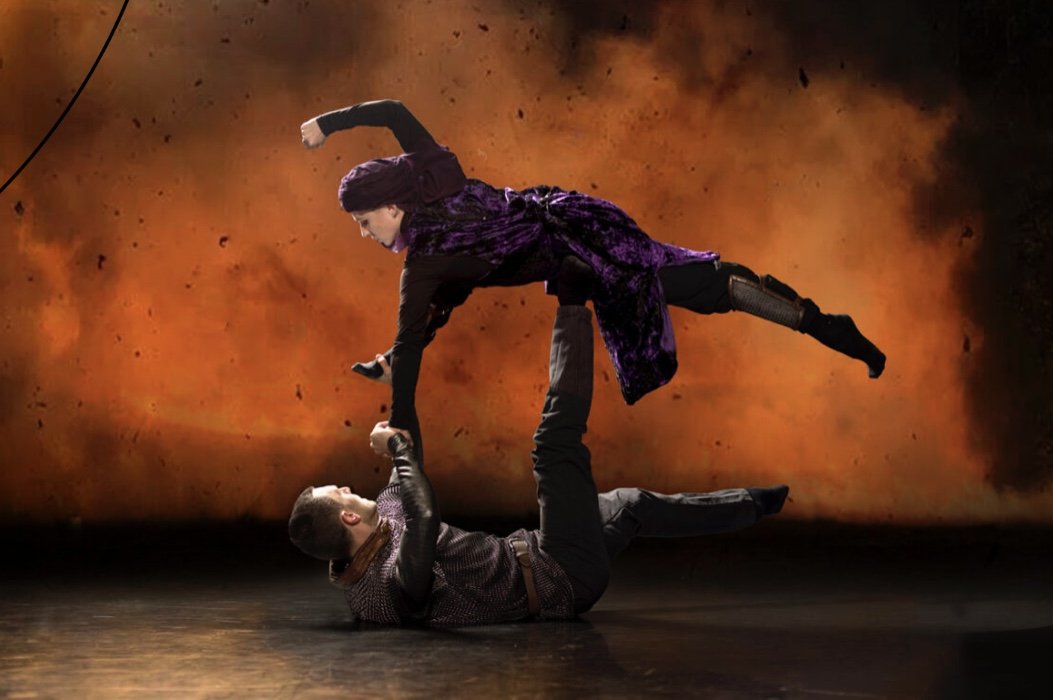Shobana Jeyasingh - Clorinda Agonistes
The choreographer Shobana Jeyasingh has been an eminent figure of the British dance scene for decades. Thirty years ago, hers was already a name that was spoken. Female, of Asian race born in Chennai, now based in London, working in idioms that combined modern dance and Indian dance, she has always commanded interest. She’s also - I speak from memories of panel discussions in the 1990s - both intelligent and eloquent.
That said, I’ve never yet been convinced she’s a dance-maker of particular skill. Since I’ve missed more Jeyasingh shows than I’ve seen, let’s hope that I’ve always missed the best ones. (That’s to say, I hope her best work surpasses those of my experience to date.) Who doesn’t hope for British Indian choreographers who combine the best qualities of Indian classical dance and Western forms? In his best work (it’s been a while now since we saw that), Akram Khan has been one such; in his worst, and in much of Jeyasingh’s, the best virtues of Indian and Western forms are equally absent. Jeyasingh’s September production at Sadler’s Wells (September 9), alas, was the worst in my experience; I write this with real disappointment.
This was Clorinda Agonistes, in which Jeyasingh applied herself to Monteverdi’s Il Combattimento di Tancredi e Clorinda, a baroque mini-epic (derived from Torquato Tasso’s longer crusading epic Gerusalemme Liberata, Jerusalem Freed, 1581) in which Tancredi fights a duel with - and falls in love with - the saracen warrior Clorinda. Clorinda, valiantly heroic fighter, can be an exciting feminist heroine, although her returning Tancredi’s love and adopting his Christian faith as she dies take her and us into now awkward terrain. Tasso opened up terrain that was to be endlessly explored by Italian opera: the conflict between love and duty, between owing allegiance to one side but losing one’s heart to someone on the other.
The American choreographer William Dollar addressed this same story in a 1949 ballet, The Duel, originally made for Les Ballets de Paris as Le Combat (the libretto was by the company’s director, Roland Petit, the music by Raffaello de Banfield), with its premiere occurring in London; Colette Marchand danced Clorinda. After being danced inParis, and New York, it was quickly taken into repertory by New York City Ballet in February 1950, with Melissa Hayden making a powerful impression as Clorinda. The late Jacques d’Amboise always recalled how, when Hayden fell spectacularly onstage at the ballet’s first performance at Covent Garden, in summer 1950, George Balanchine and Lincoln Kirstein both ran from the auditorium to see how badly Hayden, a valuable new acquisition to the company, was hurt. Dollar’s ballet is no longer well known - I’ve never seen it - but it has been revived now and then, by one company or another, into this century
Jeyasingh’s version has the great merit of using Monteverdi’s 1624 score, a cantata or madrigal for three voices; the largest vocal role is that of the narrator (the testo), with Clorinda and Tancredi singing much less. The very distinguished tenor Ed Lyon, a baroque specialist often seen with Les Arts Florissants but also at Covent Garden in Handel’s Theodora this year, sings the testo - and, remarkable artist, becomes as vivid a mover as any of the dancers.
But Jeyasingh also extends the Monteverdi score with new music by the Syrian-American composer Kareem Roustom. I’ve no purist objection to this: Roustom’s score for Dabke, a Syrian dance, has made a considerable impression in recent years. And, heaven knows, a scenario about Middle East warfare can use some local colour and local sympathy. Jeyasingh herself has written with characteristic freshness and intelligence in The Guardian about their creative process for this.
But Roustom’s music had the effect of diluting Monteverdi and prolonging the whole venture into a tedious quagmire. Although Jeyasingh has written of using Indian rhythmic complexity - and of relishing the rhythmic inner conflict of Monteverdi’s score - that’s really not the impression given to the unenlightened viewer: Clorinda Agonistes soon becomes a bore as drama, as rhythm, and as dance. It’s well known that Indian dance commutes between poetically expressionist abhinaya and the more brilliantly formal nritta, but neither aspect takes flower here. Although I’m not usually much of a costume person, I responded gratefully to the colours and fabrics of the dancers’ flaring tailcoats. Jemima Brown is Clorinda, Jonathan Goddard is Tancredi, but Jeyasingh’s staging and Lee Curran’s lighting often make the action unduly murky and ambiguous; there are long ensembles in which the sweep of coat-tails is all that matters. We see that Tancredi falls for Clorinda; we see that she admits love for him; we see that she dies. (A welcome translation of the Italian words is projected onto and above the scenery.) But then we wonder if she did indeed die. We see they were on opposite sides, but then matters carry on; and on. Sanity tells us that thus it is with modern warfare - endings are not neat - but the obscurity of Clorinda Agonistes helps neither sanity nor drama.
1.Jemima Brown (Clorinda), Jonathan Goddard (Tancredi) in Shobana Jeyasingh’s Clorinda Agonistes. Photo: Chris Nash.
2. Ed Lyon (centre) as the narrator/testo of Monteverdi’s Il Combattimento di Tancredi e Clorinda, with Jonathan Goddard (Tancredi, left) and Jemima Brown (Clorinda, right), in Shobana Jeyasingh’s Clorinda Agonistes. Photo: Tristram Kenton.
3. One of the ensembles in Shobana Jeyasingh’s Clorinda Agonistes. Photo: Chris Nash.
4. Jemima Brown as Clorinda, lifted by Jonathan Goddard as Tancredi, in Shobana Jeyasingh’s Clorinda Agonistes. Photo: Chris Nash.



